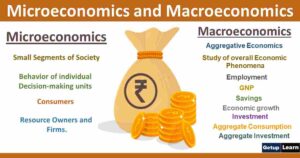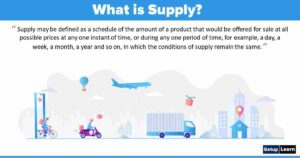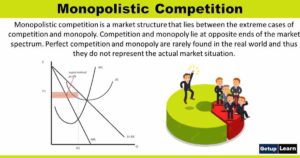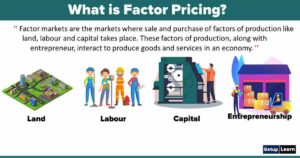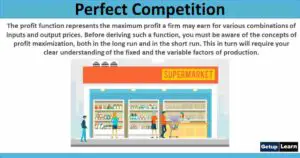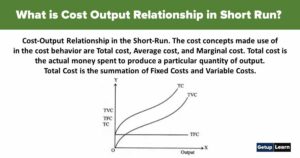Table of Contents
What is Market?
A market refers to a place where buyers and sellers are physically present to purchase and sell goods and services for a price. But in economics, the market is a comprehensive term and there is no particular place where the buyers and sellers are physically present.
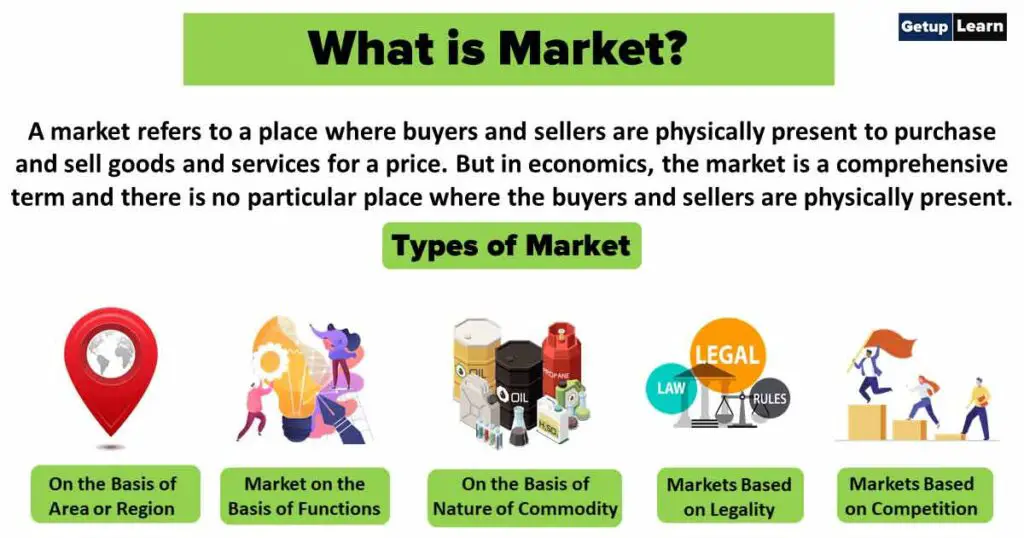
Buyers and sellers are scattered and they are in contact with one another through means of communication like letters, agents, brokers, telegraphs, telephone, newspapers, e-commerce etc. Transactions are finalized on the basis of samples and the goods are handed over or transferred from one place to another. Thus in economics market is a wider term.
Definition of Market
These are the definitions of markets by some economists:
In economics, the term market is used to an area where buyers and sellers of a particular commodity are scattered and are in contact with one another to purchase and sale of goods and services. Different definitions have been given by different economists. Some of these are described below:
[su_quote cite=”Prof. Stonier and Prof. Hague”]”By market economists mean any organisation whereby buyers and sellers of goods are kept in close touch with each other”[/su_quote]
[su_quote cite=”Professor Coornot”]“Economists understand by the term market, not any particular marketplace in which things are brought and sold but the whole of any region in which buyers and sellers are in such free intercourse with one another that the prices of the same goods tend to equality easily and quickly.”[/su_quote]
[su_quote cite=”Professor Jevons”]“But the word has been generated so as to mean any body of persons who are in intimate business relations and carry on extensive transactions in any commodity.”[/su_quote]
[su_quote cite=”Professor J.C. Edwards”]“A market is that mechanism by which buyers and sellers are brought together. It is not necessarily a fixed place.”[/su_quote]
[su_quote cite=”Professor Chapman”]“The term market refers not necessarily to place but always to a commodity and the buyers and sellers who are in direct competition with one another.”[/su_quote]
[su_quote cite=”Professor J.K. Mehta”]“By a market economists mean any organization whereby buyers and sellers of a good are kept in close touch with each other.”[/su_quote]
Features of Market
The following are the salient features of a market:

One Area
The market does not mean that the buyers and sellers of a commodity are physically present. But the market is one area or region in which buyers and sellers of the commodity are scattered. They are in close touch with one another through different means of communication.
Buyers and Sellers
Exchange requires at least one buyer and one seller of a commodity. Buyers and sellers are a must for a market. Transactions take place between sellers and buyers but their physical presence is not necessary. They may have contact through different types of communication.
One Commodity
For the existence of a market, there should be attested one commodity like wheat, vegetables, ghee, sugar etc. and the market is termed as cloth market, wheat market, vegetable market etc.
Knowledge of the Market
Buyer and seller possess knowledge of market-related to available goods, their features, uses etc.
Classification of Markets
Markets can be classified into several categories on the basis of the elements found in their existence. They are as below:
- On the Basis of Area or Region
- Market on the Basis of Functions
- On the Basis of Nature of Commodity
- Markets Based on Legality
- Markets Based on Competition
- Monopoly Market
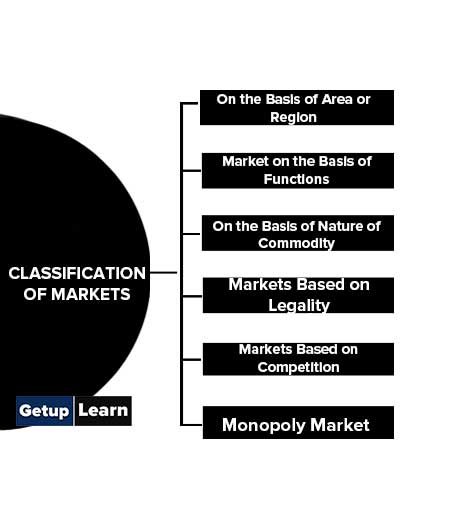
On the Basis of Area or Region
On the basis of area or region a market can be classified into the following categories:
Local Market
When buyers and sellers of certain commodities are limited to an area or region then the market is called local market. Heavyweight goods and perishable goods have the local market because their demand is concerned with a particular area or region like bricks, stones, milk, vegetables etc.
Regional Market
If the buyers and sellers of a commodity are concentrated to a certain region or state, the market is called a regional market. The area is wide than the local market.
National Market
When the demand for some goods is limited to the boundary of the country, the market is called the national market.
International Market
When the demand for goods crosses the boundary of a country, the market is called the international market. Gold, silver, food grains and medicines are bought and sold throughout the world. Hence their market is an international market.
Market on the Basis of Functions
On the basis of functions markets can be classified into the following categories:
Mixed or General Market
A market where all types of goods are bought and sold is called a mixed or general market. Markets in cities are found in this category like a departmental store.
Specialized Market
A market where a particular commodity is sold is called a specialised market like the Vegetable market, food grains market, cloth market etc.
Marketing by Samples
When the goods are bought and sold on the basis of samples, the market is called marketing by samples. Oilseeds, food grains and raw cotton are bought and sold on the basis of samples.
Marketing by Grades
When the goods are graded and then different buyers and sellers deal in such goods on the basis of their grades, then the market is called marketing by grades. Agricultural products are graded and then they are sold accordingly.
On the Basis of Nature of Commodity
The market is also classified on the basis of nature of commodity as given below:
Product Market
A market where a particular product is bought and sold is called a product market. For example, agricultural products are sold in agricultural markets (Krishi Mandis) is a market of this type.
Stock Market
A market where stock and shares, bonds, securities, debentures etc. are bought and sold is called the stock market. Bulls and bears are engaged in finalizing the transaction as per the market rates.
Bullion Market
A market where silver and gold are bought and sold is called the bullion market. In this market metallic trading takes place.
Markets Based on Legality
On the basis of legality markets can be put into two categories as given below:
Legal Market
A market where legal transactions of goods and services take place between buyers and sellers. It is recognized by the government. It is also called a fair market.
Illegal Market
A market where high prices are charged what has been fixed by the government and it happens when the goods are in short supply. Business men and trades earn profits by indulging in black marketing, smuggling and hoarding.
Markets Based on Competition
On the basis of competition can be of following categories:
- Perfect Competition or Pure Competition
- Features of Perfect Competition
- Imperfect Competition
- Forms of Imperfect Competition
Perfect Competition or Pure Competition
A market structure where a large number of buyers and sellers sell homogeneous products at a uniform price is called perfect competition.
Professor Leftwitch has defined, “Perfect competition is a market in which there are many firms selling identical product with no firm being large enough relative to the entire market so as to be able to influence the market price.”
Features of Perfect Competition
The following are the salient features of perfect competition:
-
A Large Number of Buyers and Sellers: There is a large number of buyers and sellers of a commodity under this market structure. No individual seller or buyer is in a position to influence the market price as they sell or purchase a small portion of the total stock available in the market.
-
Homogeneous Product: The product sold by various firms in this market is identical. Identical product means that each unit of the product is perfect substitute.
-
Free Entry and Exist of Firms in an Industry: In this market each individual firm is free to enter and exit the industry whenever they are interested. There are no restrictions on the entry and exit of firms in the industry.
-
Perfect Mobility of Factors of Production: All the factors of production have perfect mobility. Whenever there is change in their remuneration they can move from low paid remuneration to highly paid remuneration in other industries under this type of market.
-
Perfect Knowledge of Market Conditions: Under this type of market buyers and sellers have perfect knowledge regarding the price of the product, its availability and who are selling the product and who are buying the product. Perfect knowledge leads to existence of single price in the market.
-
No transport Cost: Under this market there is no transport cost because the market is adjust to the area. Commodity is easily carried away from one part of the market to another that there is no need of transport cost.
- Absence of Artificial Restrictions: Under this type of market there is non-existence of any artificial restrictions on the demand and supply of the product, prices of inputs and products and price determination.
Pure Competition
Prof. Edward Chamberlin has distinguished perfect competition and pure competition. He says that in pure competition there is a lack of monopoly elements. The following are the salient features of pure competition:
- A large numbers of buyers and sellers
- Homogenous product
- Free entry and exist of firms in an industry
Professor Baumol has defined, “An industry is said to be operating under conditions of pure competition when there are many firms, homogeneity of products, freedom of entry and exit, independent decision-making.”
Thus the above characteristics are also found in perfect competition. We can say that perfect competition is a comprehensive term and it includes pure competition in it.
Imperfect Competition
Another type of market structure based on competition is imperfect competition. There is a small number of firms selling differentiated products. The concept of imperfect competition was developed by Mrs Joan Robinson and Professor Chamberlin in 1933.
Under this market there is a large number of buyers and sellers with product differentiation, there are no restrictions on the entry and exit of firms but there is an existence of non-price competition among these differentiated products.
Mrs. Joan Robinson has defined, “Imperfect competition is the stage between perfect competition and monopoly.” Professor Lerner has defined, “Imperfect competition obtains when the seller is confronted with a falling demand curve for the product.”
According to Professor Chamberlin, “Competition is said to be imperfect if the number of sellers is limited and there is product differentiation.”
On the basis of definitions of imperfect competition we can say that the following are the salient features of imperfect competition:
- A small number of buyers and sellers.
- Ignorance of buyers and sellers.
- Product differentiation.
- Differences in prices.
- Non-price competition or advertisement and sales promotion.
- High transport cost.
- Other factors prevailing in the market namely trade mark, behavior of sellers, credit facility, home delivery and repair services, guarantee, samples etc.
Forms of Imperfect Competition
There are different forms of imperfect competition are as given under:
- Monopolistic competition
- Oligopoly
- Duopoly
Continue Your Reading: What is Monopolistic Competition?
Monopoly Market
When there is a single seller or producer of a commodity or service the market structure is called a monopoly market. He has full control of its supply and there is no close substitute. Like Rajasthan State Electricity Board, Railways are examples of this type of market structure.
Definition of Monopoly Market
Some of the definitions of monopoly market are given below:
[su_quote cite=”Stonier and Hague”]“It can be well remarked that the producer under pure monopoly is so powerful that he is always able to take the whole of all consumers income whatever levels of his output. The average revenue curve of the firm under pure monopoly will be a rectangular hyperbola with an elasticity of demand equal to unity.”[/su_quote]
[su_quote cite=”Professor Chamberlin”]“A monopolist should be taken that who has full control over the supply of a particular product.”[/su_quote]
[su_quote cite=”Professor Ferguson”]“A pure monopoly exists when there is only one producer in a market. There are no direct competitors.”[/su_quote]
Thus, a monopoly market structure is that where there is a single seller of a commodity having full control over its supply and there is no close substitute.
Characteristics of Monopoly
On the basis of above definitions we can describe the characteristics of monopoly market structure as given below:
-
Single Seller and Large number of buyers of a commodity or service is the characteristics of monopoly market. Individual buyer cannot influence the price of the product.
-
No Close Substitute: Under monopoly market the commodity or service sold by the seller has no close substitute.
-
One Firm or One Industry: The seller or producer of a commodity or service is firm as well as an industry. There is no distinction between the firm and industry under the monopoly market.
-
Restrictions on the Entry: Under monopoly no firm can enter the industry or market as there are several type of artificial and natural restrictions imposed by the monopolist. These restrictions may be in the form of copy right, patent, license, owner of mines etc.
-
Control Over the Supply: Under monopoly the seller of a commodity has full control over the supply and he is a price maker. He is free to fix whatever price he charges in order to attain his objective of maximization of profit.
- Either Price of Supply Fixation: A monopoly either fixes the price or determines the supply of its product. He does not do both the things simultaneously. In order to maximize his profit he will either fix the price or control the supply of his output.
What is Market?
In economics the term market is used to an area or region where buyers and seller of a particular commodity are scattered and they are in close contact with each other to purchase and sale of goods and services
What are the three definitions of market?
Economists understand by the term market, not any particular marketplace in which things are brought and sold but the whole of any region in which buyers and sellers are in such free intercourse with one another that the prices of the same goods tend to equality easily and quickly.
What is imperfect competition in economics with examples?
This is a market in which there are large number of buyers and sellers with product differentiation, there is no restrictions on entry and exit of firms but there is an existence of non-price competition among the sellers of these differentiated products.
What is perfect competition?
A market structure where a large number of buyers and sellers selling homogeneous product at an uniform price is called perfect competition.



